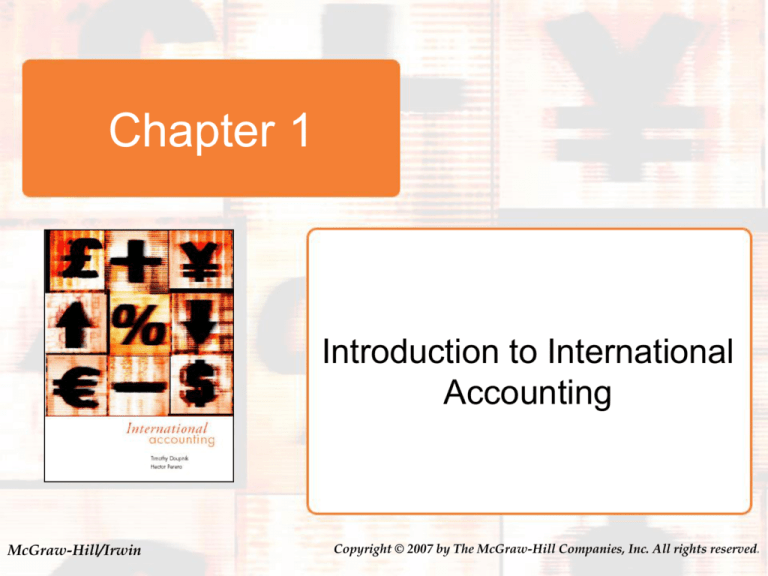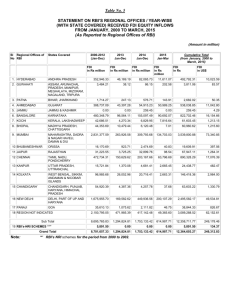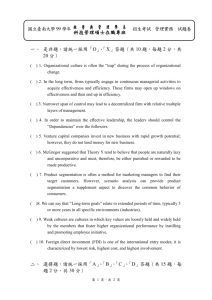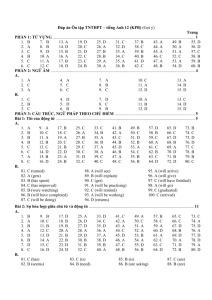
Chapter 1
Introduction to International
Accounting
McGraw-Hill/Irwin
Copyright © 2007 by The McGraw-Hill Companies, Inc. All rights reserved.
Introduction to International Accounting
Learning Objectives
1.
Understand the nature and scope of
international accounting
2.
Describe accounting issues created by
international trade
3.
Explain reasons for, and accounting
issues associated with, foreign direct
investment (FDI)
1-2
Introduction to International Accounting
Learning Objectives
4.
Describe the practice of cross-listing on
foreign stock exchanges
5.
Explain the notion of international
harmonization of accounting standards
6.
Examine the importance of international
trade, FDI, and multinational enterprises
(MNEs) in the global economy
1-3
What is International Accounting?
International Accounting can be
described at three different levels:
The influence on accounting by international
political groups such as the OECD, UN, etc.
The accounting practices of companies in
response to their own international business
activities
The differences in accounting standards and
practices between countries
Learning Objective 1
1-4
International Transactions, FDI and Related
Accounting Issues
Sale to foreign customer
Most companies’ first encounter with
international business occurs as sales to
foreign customers.
Often, the sale is made on credit and it is agreed
that the foreign customer will pay in its own
currency (e.g., Mexican pesos).
Learning Objective 2
1-5
International Transactions, FDI and Related
Accounting Issues
Sale to foreign customer
This gives rise to foreign exchange risk as the
value of the foreign currency is likely to change in
relation to the company’s home country currency
(e.g., U.S dollars).
Learning Objective 2
1-6
International Transactions, FDI and Related
Accounting Issues
Sale to foreign customer
Suppose that on February 1, 2006, Joe Inc., a U.S.
company, makes a sale and ships goods to Jose,
SA, a Mexican customer, for $100,000 (U.S.).
However, it is agreed that Jose will pay in pesos
on March 2, 2006. The exchange (spot) rate as of
February 1, 2006 is 10.00 pesos per U.S. dollar.
How many pesos does Jose agree to pay?
Learning Objective 2
1-7
International Transactions, FDI and Related
Accounting Issues
Sale to foreign customer
Even though Jose SA agrees to pay 1,000,000
pesos ($100,000 x 10.00 pesos/U.S. $), Joe, Inc.
records the sale (in U.S. dollars) on February 1,
2006 as follows:
Dr. Accounts receivable (+) 100,000
Cr. Sales revenue (+)
100,000
Learning Objective 2
1-8
International Transactions, FDI and Related
Accounting Issues
Sale to foreign customer
Suppose that on March 2, 2006, the spot rate for
pesos is 11 pesos/U.S. $). Joe Inc. will receive
1,000,000 pesos, which are now worth $90,909.
Joe makes the following journal entry:
Dr. Cash (+)
90,909
Dr. Loss on foreign exchange (+) 9,091
Cr. Accounts receivable
100,000
Learning Objective 2
1-9
International Transactions, FDI and Related
Accounting Issues
Hedging
Joe can hedge (i.e., protect itself) against a loss
from an exchange rate fluctuation. Hedging can
be accomplished by various means, including:
Foreign currency option – the right (but not the
obligation) to purchase foreign currency at a
specific exchange rate for a specified period of
time.
Learning Objective 2
1-10
International Transactions, FDI and Related
Accounting Issues
Hedging
Forward contract – this is an obligation to
exchange foreign currency at a date in the future,
typically 30, 60 or 90 days.
Learning Objective 2
1-11
International Transactions, FDI and Related
Accounting Issues
Foreign Direct Investment (FDI) – occurs when a
company invests in a business operation in a
foreign country. This represents an alternative to
importing to customers and/or exporting from
suppliers in a foreign country. Two types of FDI
are Greenfield investment and acquisition.
Learning Objective 3
1-12
International Transactions, FDI and Related
Accounting Issues
Foreign Direct Investment (FDI)
Greenfield investment – the establishment of a
new operation in the foreign country
Acquisition – investment in an existing operation
in the foreign country.
Learning Objective 3
1-13
International Transactions, FDI and Related
Accounting Issues
FDI creates two primary issues:
The need to convert from local to U.S. GAAP
since accounting records are usually prepared
using local GAAP.
The need to translate from local currency to
U.S. dollars since accounting records are usually
prepared using local currency.
Learning Objective 3
1-14
International Income Taxation
Foreign income taxes – the foreign
government will tax the company’s profits at
applicable rates.
U.S. income taxes – the U.S. will tax the
company’s foreign-based income.
Learning Objective 3
1-15
International Transfer Pricing
Transfer pricing – setting prices on goods and
services exchanged between separate divisions
within the same firm. These prices have a direct
impact on the profits of the different divisions.
Learning Objective 3
1-16
International Transfer Pricing
These exchanges are not arms-length
transactions, thus giving rise to the certain
problems in an international context:
Taxation – governments in the various countries
often scrutinize transactions to assure that
sufficient profits are being recorded in that country.
Learning Objective 3
1-17
International Transfer Pricing
Performance evaluation issues – to the extent
that division managers are evaluated based on
divisional profits, transfer prices influence
division manager performance evaluation.
Learning Objective 3
1-18
International Auditing
Both internal and external auditors encounter
differences that arise between auditing in an
international vs. domestic context. These
include:
Language and cultural differences
Different accounting standards (GAAP) and
auditing standards (GAAS)
Learning Objective 3
1-19
Cross-listing on Foreign Stock Exchanges
MNEs frequently raise capital outside their
home country. When a company offers its
shares on an exchange outside of its home
country, this is referred to as Cross-Listing.
Learning Objective 4
1-20
International Harmonization of Accounting
Standards
The international movement towards a single
set of worldwide accounting rules is referred to
as Harmonization. International Accounting
Standards (IAS) and U.S. GAAP are currently
the two most important sets of accounting
rules.
Learning Objective 5
1-21
International Harmonization of Accounting
Standards
The Norwalk Agreement
Published in 2002.
Is a promise of cooperation in standard-setting
between the International Accounting Standards
Board (IASB) and the Financial Accounting
Standards Board (FASB).
Represents a significant step toward
international harmonization.
Learning Objective 5
1-22
The Global Economy
Several indicators demonstrate the extent of
business globalization:
International trade – In 2001 exports worldwide
topped $6 trillion. Between 1987 and 1999, U.S.
exporters increased by 233% in number.
Foreign Direct Investment – Between 1982
and 1999 worldwide FDI inflows increased from
$58 billion to $865 billion.
Learning Objective 6
1-23
The Global Economy
Several indicators demonstrate the extent of
business globalization:
Multinational enterprises (MNEs) –
Companies that have headquarters in one
country and operate in one or more other
countries. Currently, MNEs account for over
one-quarter of the world’s Gross Domestic
Product (GDP).
Learning Objective 6
1-24
The Global Economy
Several indicators demonstrate the extent of
business globalization:
International capital markets – In 2001 there
were 462 companies representing 53 countries
cross-listed on the New York Stock Exchange
(NYSE). In addition, over 60 U.S. companies are
cross-listed on foreign exchanges…
Learning Objective 6
1-25









